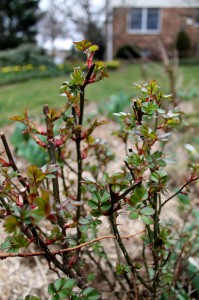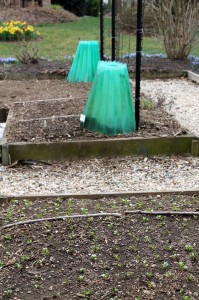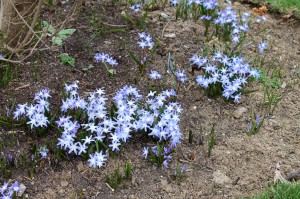Pruning and the Weather
March 20th, 2012
I’ve never seen this long of a run of unusually warm weather this early.
I’m getting all kinds of questions from gardeners wondering whether they should move up their planting and yard-care schedule and what’s going to happen if a cold spell occurs.
I could answer a lot better if I knew what the weather was going to do between now and our “usual” no-threat-of-frost time of mid-May.
Just because it’s 70s in March doesn’t mean killing cold is out of the question in April. So I’m a little reluctant to tell everyone to go hog wild like winter weather is history.
On the other hand, it’s also possible that a March in the 70s will lead to an April in the 80s and a May in the 90s. In that case, we’ll have missed weeks of gardening opportunity and end up doing some things later than we should’ve.
For what it’s worth, here’s what I decided to do…
* Pruning: Done. I took my cue from how plants were progressing. Since the roses were unfurling leaves already and the evergreens were popping out new buds, that told me it was time to get busy.
The idea is to prune summer-blooming shrubs (butterfly bush, rose-of-sharon, caryopteris, tree-type hydrangeas, etc.) and most evergreens (hollies, boxwoods, arborvitae, yews, hemlocks, falsecypress, etc.) before they have a chance to waste energy on wood that you’re only going to cut off anyway.
One question I get all the time is when and how to prune ‘Knock Out’ roses. Be ruthless, and do it ASAP. I cut mine down already to ankle-high to keep them compact. I also give them a lighter shear or prune around the end of June after the first main bloom. I’ve pruned ‘Knock Outs’ nicely with hand-pruners and butchered them mercilessly with shears, and they grow back fine either way.
* The Vegetable Garden. Planted. My vegetable garden is filled with cool-season crops. I actually started March 1 this year – two weeks earlier than ever – with radishes, peas and spinach. I’ve since added a second and third planting of radishes and also two plantings of lettuce, peas and beets.
This past weekend I finished off the garden with ‘Kennebec’ and ‘Red Norland’ potatoes (thanks to a gift from church-mate and Pennsylvania’s “Johnny Potatoseed” Roger Springer), transplants of broccoli, cabbage, purple cauliflower, raddichio, chard and kale, and seeds of carrots.
I even have two tomatoes in the ground under Wall o’ Water plant protectors. I’ll keep an eye on the weather and possibly get beans, cucumbers, peppers, eggplants and the main crop of tomatoes in sooner than the usual planting time of early to mid-May. I don’t want to rush these too much.
* Planting. I’ve already moved a few shrubs and perennials and plan to get a new paperbark maple in the ground as soon as I can.
I think we’re safe planting and transplanting anything we’d normally do in April. Just watch in case we get some freezes and thaws… that can push up newly planted plants. If that happens, just tamp the plants back down and give them a fresh dose of water.
Don’t go overboard and try to plant your annual flowers and tender veggies, though. You’re OK with pansies, violas, dusty miller, snapdragons and similar cool-season fare, but hold off on things that a frost will kill (i.e. petunias, annual salvia, zinnias, marigolds, celosia, impatiens, vinca, etc.) Wait until end of April or early May and look at the 10-day forecast before planting those.
* Mulching. My neighbor, Tom, put down a good 8 yards of mulch from the township by mid-March. The soil’s warm enough this year, and the weeds are germinating early enough that this is another job I’d have checked off, too, if I had had the time.
Go ahead and put down your mulch as soon as you’re able.
* Weed Control. I think we’re heading for a bad weed year. The combo of a wet season last year and a mild winter that didn’t kill off borderline-hardy weeds spells double trouble. Tons of cool-season weeds like chickweed, creeping veronica and henbit are off to a spectacular start.
If you use weed-preventers like Preen, corn gluten meal and crabgrass preventers, get them down now. A good cue for these is when forsythia is in full bloom, which happened this past weekend.
This just goes to show why it’s better to plan your jobs around nature’s seasonal cues than the calendar.
* Watering. I’ve never seen the soil this warm and this dry so early. The top inch or so of my vegetable garden was actually dry and dusty last weekend – much like it gets in June.
Since I started planting and transplanting stuff in early March, I’ve already been watering. My hoses are out and in use.
Again, water when the soil calls for it, not by what the calendar says.
I’ve also taken the winter protection off my fig tree (tarp stuffed with leaves) and got the water garden cleaned up with the fountain running. Still to come: bring out the birdbath, patio fountain, statues and other garden accessories that I store in the garage over winter.
I managed to take a little time to enjoy the colorful life in my yard at a time when some years it’s still covered in snow.
I’ve got glory-of-the-snow, daffodils and Siberian squill bulbs blooming their heads off, a ‘Mellow Yellow’ spirea covered in white, birds galore and the best bloom ever for the pair of 8-foot-tall hardy camellias growing along the east wall of my house.
I’ll take this any time over a March blizzard.










